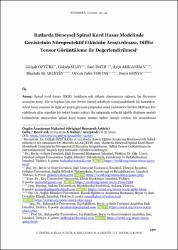Ratlarda Deneysel Spinal Kord Hasar Modelinde Genisteinin Nöroprotektif Etkisinin Araştırılması, Diffüz Tensor Görüntüleme ile Değerlendirilmesi

Göster/
Tarih
2020Yazar
Öztürk, GülşahSilav, Gökalp
İncir, Said
Arslanhan, Ayça
Akçetin, Mustafa Ali
Toktaş, Orkun Zafer
Konya, Deniz
Üst veri
Tüm öğe kaydını gösterÖzet
Amaç: Spinal kord hasarı (SKH), insidansı çok yüksek olmamasına rağmen, bu durumun sonuçları birey, aile ve toplum için son derece önemli sekellerle sonuçlanabilecek bir hastalıktır. Nöral hasar onarımı ile ilgili her geçen gün yeni çalışmalar umut vadetmekle birlikte SKH için kür olabilecek altın standart bir tedavi henüz yoktur. Bu çalışmada ratlarda ağırlık düşürme modeli kullanılarak oluşturulan spinal kord hasarı sonrası tedavi amaçlı verilen; bir tirozinkinaz inhibitörü olan Genistein (GEN) isimli fitoöstrojenin etkisi araştırılmış ve geç dönemde sayılı rat üzerindeki diffüzyon tensör görüntüleme (DTG) ile sonuçları değerlendirilmiştir.
Yöntem: Çalışma Marmara Üniversitesi Başıbüyük Nörolojik Bilimler Enstitüsü’nde yapıldı. Çalışmada toplam 28 adet 200-250 gr ağırlığında Sprague-Dawley sıçan randomize olarak 4 eşit gruba bölündü: Grup 1 (n=7 sıçan) kontrol grubu (sadece laminektomi uygulanan), Grup 2 (n=7 sıçan) travma grubu, Grup 3 (n=7 sıçan) travma + dimetil sülfoksid (DMSO) uygulanmış grup, Grup 4 (n=7 sıçan) travma+DMSO+GEN (0,25 mg /kg/rat GEN) uygulanmış grup. Genistein DMSO aracılığıyla çözülebilen bir maddedir. Grup 1’e sadece T10-12 laminektomi uygulandı. Grup 2, 3 ve 4’e T10-12 total laminektomi sonrası ağırlık düşürme modeli kullanılarak spinal kord travması yapıldı. Grup 4’e 7 gün boyunca 0,25 mg/kg/rat GEN uygulandı. Grup 1’den bir, diğer gruplardan 3’er adet toplam 10 adet randomize seçilen ratın spinal kordu postoperatif 28. günde Diffüzyon tensör görüntüleme ile değerlendirildi. Alınan doku örnekleri Hematoksilen-Eosin (HE), Kristal Viole ve Luksol Fast Blue (LFB) ile boyanıp ışık mikroskobunda incelendi. Çalışmada kullanılan tüm ratlar postoperatif 6. saat, 24. saat, 7., 14., 21. ve 28. günlerde lökomotor derelecelendirme skalası (BBB) kullanılarak değerlendirildi.
Bulgular: GEN grubunda, diğer travma gruplarına göre fonksiyonel iyileşme puanları daha iyi olmasına rağmen tüm travma grupları arasında anlamlı istatistiksel fark gözlenmemiştir (p>0.05). Travmadan 28 gün sonra alınan görüntü örneklerinde, travma uygulanan gruplarda, lezyon merkezinde fraksiyonel anizotropi (FA) değerlerinin azaldığı gözlenmiştir.
Sonuç: Spinal kord travmasında GEN etkinliği, GEN uygulanmış travma grubunda, diğer travma gruplarıyla karşılaştırıldığında nörolojik iyileşmede BBB motor skala sonuçlarına göre artış göstermiş olup istatistiksel olarak anlamlı sonuç elde edilmemiştir. Çalışma, spinal kord travmasında GEN kullanımı için temel bir bilgi düzeyi oluşturmuş olup daha geniş kapsamlı bir çalışmada doz bağımlı araştırma yapılabilir. Yardımcı tanısal araç olarak kullanılan DTG’nin travma sonrası takipte önemli rol alabileceği öngörülmüştür. Aim: Spinal cord injury (SCI) is a wide spectrum of a devastating disease which has significant effects on individuals, families or society even though the incidence is low. Studies on neural tissue repair have huge progress in recent years but spinal cord injury still remains a troublesome condition with no definitive cure. In this study, we aimed to explore the effectiveness of Genistein (GEN), a phytoestrogen and tyrosine kinase inhibitor in a rat thoracic weight drop SCI model and to evaluate the long term results with diffusion tensor imaging (DTI), locomotion and histopathological changes.
Method: This study was conducted at Marmara University Basıbuyuk Neurological Sciences Institute. In our study twenty-eight, 250 g weighted, young adult Sprague-Dawley rats were used. They were randomly divided into four equivalent groups: 1.group Sham (n=7) 2. group Experimental spinal cord injury (SCI) (n=7) 3. group SCI + dimethyl sulfoxide (DMSO) (n=7) 4. group SCI+ DMSO+ GEN (0,25 mg /kg/rat GEN)(n=7). In the first sham group, only T10-12 laminectomy was done. Spinal cord trauma was performed in Group 2, 3 and 4 using the weight-drop model after T10-12 total laminectomy. GEN was dissolved in the vehicle DMSO. SCI+ DMSO+ GEN rat model: GEN (0,25 mg /kg/rat GEN) were given to rats subjected to SCI for 7 days. One rat from the first group, three from the 2nd group, three from 4th group, in total 10 rats were randomly chosen and magnetic resonance imaging (MRI) performed with DTI at 28th day. Tissue samples were stained with Hematoxylin-Eosin (HE), Crystal Viole and Luxol Fast Blue (LFB) and examined under a light microscope. The Basso-Beattie-Bresnehan (BBB) locomotor rating scale was performed at 6th hour, 24th hour and weekly for four weeks for all the rats.
Results: In GEN group, there was a higher functional improving but, there was no statistical significiantly differences (p>0.05) between all trauma groups. At 28th day of the injury, we took images of all groups which had been chosen randomly and we found that Fractional Anisotropy (FA) decreased at the epicenter zone.
Conclusion: According to BBB motor scale results in terms of effectiveness of GEN in the spinal cord injury; although compared to the other groups, we obtained increased neurological recovery. Results were not statistically significant. Study creates a basic level of knowledge about the GEN dosage and activity in the spinal cord injury, but a more comprehensive dose-dependent research study should be performed. DTI seems as a helpful diagnostic tool in study and it can take an important role on follow-up after trauma.
Sayı
11Bağlantı
https://hdl.handle.net/11363/2392Koleksiyonlar
Aşağıdaki lisans dosyası bu öğe ile ilişkilidir:

















